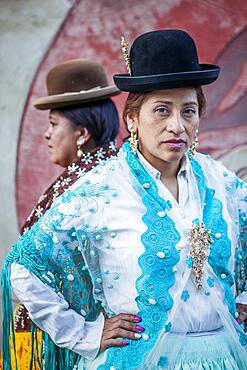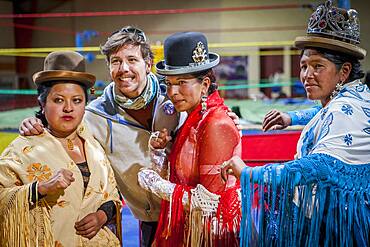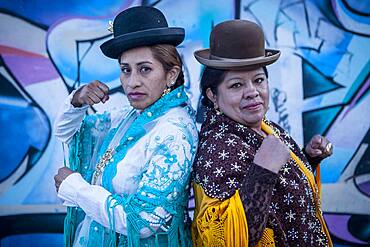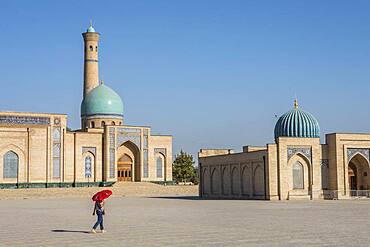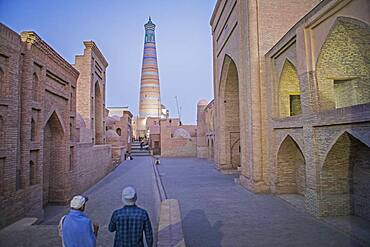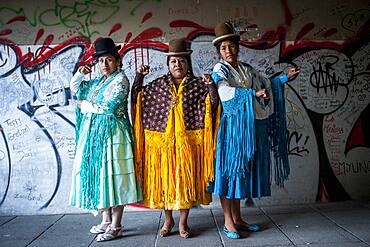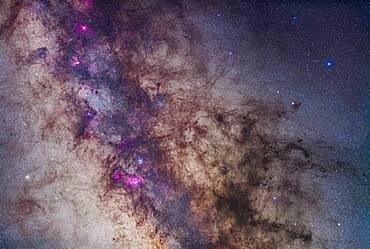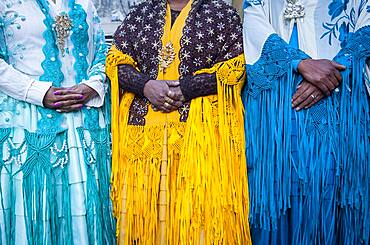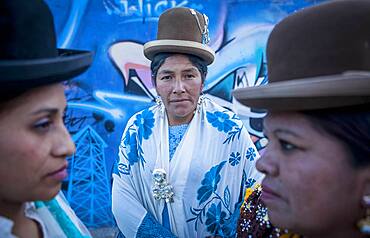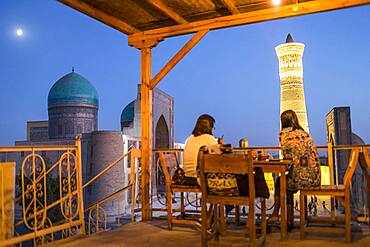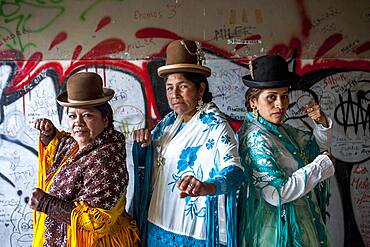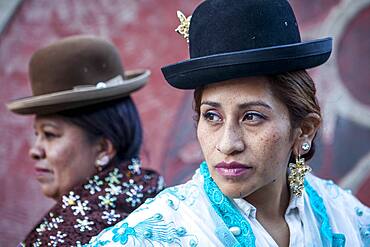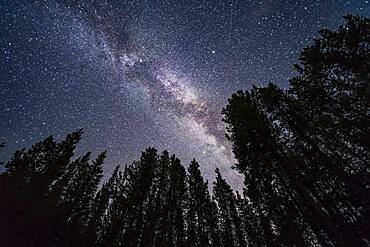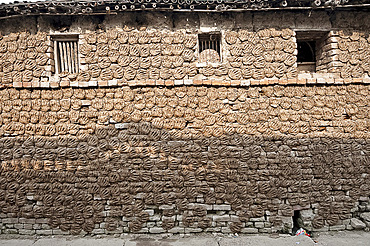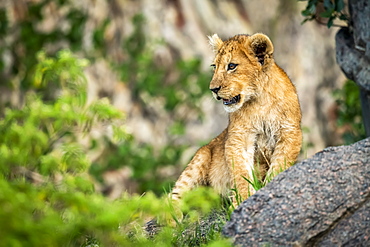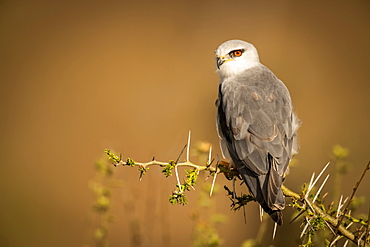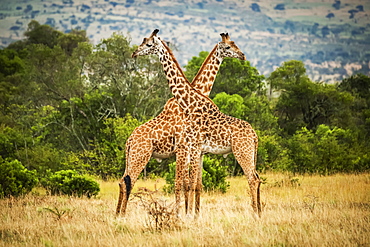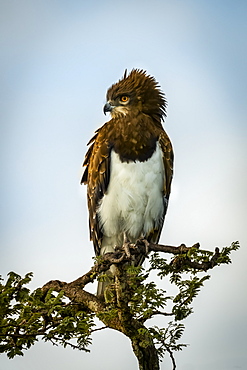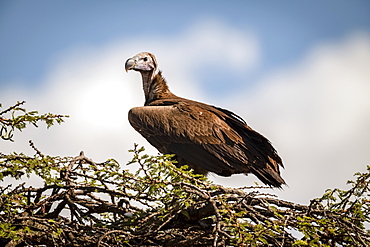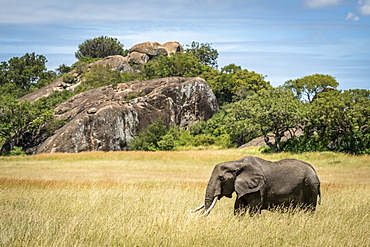Recent searches
Loading...
1350-95 - M31, the Andromeda Galaxy, with its companion galaxies, M32 (below) and M110 (aka NGC 205, above), framed to include the blue star Nu Andromedae at left, usually used as the star hopping guide star to find M31.
1350-89 - The Horsehead Nebula, B33, below the Belt of Orion and the star Alnitak, along with the bright Flame Nebula, NGC 2024, to the left of Alnitak. Many other bright reflection nebulas populate the field, such as NGC 2023 just left of the Horsehead itself. The quintuple star system Sigma Orionis is right of the Horsehead. The dark Horsehead is set against the bright streak of the emission nebula IC 434.
1350-817 - At left Dina , in the middle Benita la Intocable, at right Angela la Folclorista, cholitas females wrestlers, El Alto, La Paz, Bolivia
1350-87 - A mosaic of the region in Cassiopeia and Cepheus containing the main nebulas: the Bubble Nebula (NGC 7635) at lower left, and the Cave Nebula (Sh 2-155) at upper right. At left is also the bright Messier open cluster M52. The small yellowish cluster at right is NGC 7419. The small cluster at lower centre is NGC 7510. The small nebula just left of centre is NGC 7538.
1350-126 - Splendours of the southern Milky Way from Vela (at top right) to Centaurus (at bottom left), including the Carina Nebula, Crux and Coal Sack, and Alpha and Beta Centauri. A part of the huge Gum Nebula is at far right. The False Cross is at right, with the large cluster NGC 2516, the Diamond Cluster, below it. The globular cluster Omega Centauri is at upper left.
1350-1338 - At right minaret of Sidi Lazaze, at left minaret of Medersa Bou Inania, Medina, UNESCO World Heritage Site, Fez, Morocco, Africa.
1350-90 - The supernova remnant IC 443 in Gemini near the stars Mu (left) and Eta (right) Geminorum. Slight haze passing thru on some exposures added the star glows.
1350-613 - A panoramic view of Perito Moreno Glacier in Los Glaciares National Park near El Calafate, Argentina. A UNESCO World Heritage Site in the Patagonia region of South America. At left is Cerro Moreno and the Cordon Reichert at right. In the background are Cerro Gardener, Teniente Iglesias and Cerro Dos Picos.
1350-826 - Detail of dresses and feet. At left Benita la Intocable , in the middle Angela la Folclorista, and at right Dina, cholitas females wrestlers, El Alto, La Paz, Bolivia
1350-27 - The nebulas of Orion in the Belt and Sword of Orion area. Including M42, Orion Nebula 9below centre), Barnard's Loop (at left), M78 (small reflection nebula above centre), Horsehead Nebula (centre) and NGC 2024 (above Horsehead). There is faint reflection nebulosity at right -- the frame does not extend right far enough to show the Witchhead Nebula near Rigel.
1350-819 - At right Benita la Intocable , at left Angela la Folclorista, cholitas females wrestlers, El Alto, La Paz, Bolivia
1350-61 - The Celestron GPS8 scope looking at M22 in the Milky Way in the light of the rising waxing gibbous Moon, from the backyard July 21, 2019. Jupiter is bright at right, Saturn at left.
1350-1337 - At right minaret of Sidi Lazaze, at left minaret of Medersa Bou Inania, Medina, UNESCO World Heritage Site, Fez, Morocco, Africa.
1350-45 - This is the central area of Cygnus and its bright Milky Way starcloud surrounded by red nebulosity. At left is the star Sadr (gamma Cygni) with the complex of nebulosity catalogued as IC 1318. At centre is the distinct Crescent Nebula, NGC 6888, a expanding nebula created by winds from a hot Wolf-Rayet star. At bottom left is the star cluster Messier 29, though looking a little lost in the rich starfields here. At top is the cluster IC 1311, looking more obvious than M29 but not observed visually and included in the NGC catalog. Odd. At far right are the large and loose star clusters NGC 6883 and NGC 6871, the latter an obvious binocular sight. To the left of Sadr is the small cluster NGC 6910. The dark nebulas B145 and LDN 862 are at right. The small emission nebula at bottom is Sharpless 2-104.
1350-100 - A dim aurora to the north at Grasslands National Park, Saskatchewan, at the Larson Ranch site and its rustic pioneer cabins. Taken August 8, 2016. This is looking northeast to Andromeda (the Andromeda Galaxy is above centre) and Perseus (the Double Cluster is left of centre). This Park is a Dark Sky Preserve. There are no lights visible. Illumination here is from starlight and the setting waxing crescent Moon to the southwest.
1350-154 - A blend of images to show the stars of the southern sky moving from east to west (left to right) over the peaks of the Continental Divide at Herbert Lake near Lake Louise, in Banff, Alberta. The main peak at left is Mount Temple.
1350-1099 - Takahiro Koizumi at right and his assistant kohei ishimori at left are making mud to build a molds to make a iron teapot or tetsubin, nanbu tekki,Workshop of Koizumi family,craftsmen since 1659, Morioka, Iwate Prefecture, Japan
1350-178 - The asterism of the False Cross in Vela and Carina, at left, with Gamma Velorum, a bright blue supergiant star, at right. In between are faint arcs of nebulosity in the Gum Nebula. To the left of Gamma Velorum is the open star clister NGC 2547. Below the bottom star of the False Cross, Epsilon Carinae or Avior, is the large naked-eye star cluster NGC 2516. To the right of the right star of the False Cross, Delta Velorum, is the loose open cluster IC 2391.
1350-1573 - At right Ulugh Sultan Begim mausoleum, in the middle Ustad Ali mausoleum, and at left Shad-i-Mulk Aqa mausoleum , Shah-i-Zinda complex, Samarkand, Uzbekistan
1350-133 - The amazing area of the southern Milky Way in Carina and Crux, the brightest part of the Milky Way after the galactic core region. At right is the Carina Nebula, with the Southern Pleiades cluster, IC 2602, below it. The Football Cluster, NGC 3532, is at upper left of the Carina Nebula. At centre is the region of Lambda Centauri, with the star cluster NGC 3766, the Pearl Cluster, above the emission nebulosity. At left is the Southern Cross, with the dark Coal Sack at bottom left of the Cross, with thin tendrils extending to the right. To the left of Alpha Cruxis at the bottom of the Cross is the star cluster NGC 4609; aboive Alpha is NGC 4649. To the left of Beta Cruxis at the left side of the Cross is the Jewel Box Cluster, NGC 4755.
1350-822 - At left Dina , in the middle Benita la Intocable, at right Angela la Folclorista, cholitas females wrestlers, El Alto, La Paz, Bolivia
1350-814 - At left Benita la Intocable , in the middle Angela la Folclorista, and at right Dina, cholitas females wrestlers, El Alto, La Paz, Bolivia
1350-130 - Particularly large groups of sunspots on the Sun on September 4, 2017. The group at bottom is AR 2673, the group at top is 2674. The small spot at left on the emerging limb is AR 2677, while the groups disappearing at right are AR 2675 (top) and AR 2776.
1350-601 - The jagged face of Perito Moreno Glacier and Lago Argentino in Los Glaciares National Park near El Calafate, Argentina. A UNESCO World Heritage Site in the Patagonia region of South America. Icebergs from calving ice from the glacier float in the lake. Behind at left is Cerro Moreno.
1350-139 - Curtains of aurora during an active storm on February 18, 2018 from the Churchill Northern Studies Centre, in the early evening in the last of the twilight. This night the aurora was brightest early in the evening. The Big Dipper is at left.
1350-845 - Lucha Libre. After the show. A follower is photographed with cholitas fighters. At left Julieta, in the middle Celia la Simpatica, and Dina , cholitas females wrestlers ,Sports center La Ceja, El Alto, La Paz, Bolivia
1350-829 - At left Benita la Intocable , and at right Angela la Folclorista, cholitas females wrestlers, El Alto, La Paz, Bolivia
1350-59 - A wide-angle view of the Northern Hemisphere autumn Milky, from Aquila at bottom right in thw south, to Cassiopeia and Perseus at upper left in the northeast. Cygnus is at centre overhead on a late October evening. The Summer Triangle stars are at centre and right; the Andromeda Galaxy and Triangulum galaxies are at bottom left. The dark nebula Le Gentil 3, aka the Funnel Nebula, is at centre.
1350-63 - Mark gazing at a target, M22, in the Milky Way with his TeleVue 127 refractor at the annual Rothney Observatory Milky Way Nights for July 25, 2019. Several satellite trails mark the sky. Jupiter (brightest at right) and Saturn (at left) flank the Milky Way.
1350-1586 - At left Hazroti Imom Friday Mosque and at right Moyie Mubarek Library Museum, Tashkent, Uzbekistan
1350-1524 - Islom Hoja Minaret. At right Sherghozi Khan Medressa. At left Pahlavon Mahmud Mausoleum, Khiva, Uzbekistan
1350-603 - Perito Moreno Glacier and Lago Argentino in Los Glaciares National Park near El Calafate, Argentina. A UNESCO World Heritage Site in the Patagonia region of South America. At right is Cordon Reichert with the peak of Cerro Moreno at left.
1350-127 - The region of the Milky Way in Puppis and Vela encompassing the vast Gum Nebula, a photographic object only. Sirius and Canis Major are at right; Canopus in Carina is at bottom. The False Cross and the open cluster NGC 2516 are at left.
1350-58 - This is the nebula rich region in the constellation of Monoceros the Unicorn with the dark Cone Nebula (left of centre) and the small V-shaped and bright Hubble's Variable Nebula at bottom, a reflection nebula that varies in form and brightness. Above the Cone Nebula is the triangular Christmas Tree Cluster, NGC 2264, here upside down as the bright blue star 15 Mon is the base of the tree. The large region of nebulosity is Sharpless 2-273. The V-shaped dark nebula above centre is LDN 1603.
1350-815 - At left Benita la Intocable , in the middle Angela la Folclorista, and at right Dina, cholitas females wrestlers, El Alto, La Paz, Bolivia
1350-1186 - Sahar at right and Houriye at left, both 15 years old, Girls picking chards harvest, day laborers, child labour, syrian refugees, in Bar Elias, Bekaa Valley, Lebanon
1350-827 - At left Benita la Intocable , and at right Angela la Folclorista, cholitas females wrestlers, El Alto, La Paz, Bolivia
1350-145 - A flower-filled meadow at the Hay Barn Road at Waterton Lakes National Park, Alberta, with the summer Milky Way and Mars to the south over Waterton Valley and Vimy Peak at left.
1350-607 - The jagged face of Perito Moreno Glacier and Lago Argentino in Los Glaciares National Park near El Calafate, Argentina. A UNESCO World Heritage Site in the Patagonia region of South America. Icebergs from calving ice from the glacier float in the lake. In the distance at left is Cerro Gardener.
1350-35 - A mosaic of the region around the Small Sagittarius Starcloud and Dark Horse dark nebula complex. The field takes in the Milky Way from the Lagoon Nebula at bottom to the Eagle Nebula at top left. In between from top to bottom are the Swan Nebula (M17), and the Small Sagittarius Starcloud (M24). Flanking the bright M24 starcloud are the large open clusters M23 (right) and M25 (left). At bottom left is the M22 globular star cluster. The prominent dark nebula at right is the large Pipe Nebula (B78) with the small Snake Nebula (B72) above it. The whole complex is visible to the naked eye as the Dark Horse.
1350-172 - The centre of the Galaxy region in Sagittarius and Scorpius overhead in the wee hours of an April morning in Australia. At upper right are Alpha and Beta Centauri, while at lower left is Altair.
1350-109 - The rising autumn stars and constellations over and reflected in the lake at Police Outpost Provincial Park, in southern Alberta, on September 26, 2016. The stars of Auriga and Taurus are rising, including the Pleiades at upper right. Capella is the bright star above right centre; Aldebaran is below right in the sky. Both are reflected in the still water, along with the Hyades and Pleiades star clusters. A mild aurora is at left.
1350-105 - The spectacular field of Messier 8 and 20 emission and reflection nebulas in Sagittarius, with M8, aka the Lagoon Nebula below, and M20, the Trifid Nebula, above, all set in the rich starfields of the Milky Way. The diffuse nebula left of M8 is NGC 6559. Two globular clusters, NGC 6544 and NGC 6553, sit below and to the left (east) of M8. The Messier open cluster, M21, sits above M20.
1350-79 - The Belt and Sword region of Orion, with the Orion Nebula, Messiesr 42 and 43, at bottom. Below the left star of the Belt, Alnitak, is the famous Horsehead Nebula, while above it is NGC 2024, aka the Flame Nebula. At very top left is Messier 78, while part of Barnard's Loop arc across the field at left. The field is filled with other faint red emission and blue reflection nebulas. The large loose open cluster Collinder 70 surrounds the middle star of the Belt, Alnilam.
1350-110 - Mars (at top) and Saturn (at left) in Scorpius (or thereabouts - Saturn is technically in Ophiuchus) above Antares and the dark and reflection nebulas around Antares. The globular M4 is visible to the right of Antares.
1350-17 - Nebulosity in the heart of Cygnus the Swan, including the North America Nebula and Pelican Nebula at left (NGC 7000 and IC 5070) and Gamma Cygni complex at right (IC 1318). The Crescent Nebula (NGC 6888) is at lower right. This is a stack of 5 x 4 minute exposures at f/2 with the 135mm lens and modified Canon 5D MkII at ISO 800, plus another three similar exposure images but taken thru the Kenko Softon filter for the star glows. Taken from home Sept 10, 2013.
1350-1499 - At right Kalon minaret and mosque. At left Mir-i-Arab medressa , Bukhara, Uzbekistan
1350-825 - Detail of dresses and hands. At left Benita la Intocable , in the middle Angela la Folclorista, and at right Dina, cholitas females wrestlers, El Alto, La Paz, Bolivia
1350-828 - At left Benita la Intocable , in the middle Dina, and at right Angela la Folclorista, cholitas females wrestlers, El Alto, La Paz, Bolivia
1350-821 - At left Angela la Folclorista , in the middle Benita la Intocable, and at right Dina, cholitas females wrestlers, El Alto, La Paz, Bolivia
1350-1523 - Islom Hoja Minaret. At right Sherghozi Khan Medressa. At left Pahlavon Mahmud Mausoleum, Khiva, Uzbekistan
1350-1126 - Takahiro Koizumi at left and his assistant at right are showing their finish work, iron teapots or tetsubin, nanbu tekki,Workshop of Koizumi family,craftsmen since 1659, Morioka, Iwate Prefecture, Japan
1350-1500 - Minor Cafe House. At right Kalon minaret and mosque. At left Mir-i-Arab medressa , Bukhara, Uzbekistan
1350-816 - At left Angela la Folclorista , in the middle Dina, and at right Benita la Intocable, cholitas females wrestlers, El Alto, La Paz, Bolivia
1350-820 - At right Benita la Intocable , at left Angela la Folclorista, cholitas females wrestlers, El Alto, La Paz, Bolivia
1350-47 - This is the Belt of Orion with its three blue stars across the top of the frame (L to R: Alnitak, Alnilam, and Mintaka), with the iconic Horsehead Nebula (aka B33) below Alnitak, with the dark Horsehead set against the bright nebula IC 434, aka Orion's Dagger. The pinkish nebula above Alnitak is NGC 2024, the Flame Nebula. The small blue reflection nebula left of the Horsehead is NGC 2023, with smaller IC 435 to the left of it. The field is filled with the large open cluster Collinder 70. The multiple star at bottom left of centre is Sigma Orionis. Many other smaller bits of reflection nebulas populate the field in and around the Belt.
1350-99 - The Northern Lights on Feb 16, 2015, as seen from the Churchill Northern Studies Centre, in Churchill, Manitoba at 58° latitude, and under the auroral oval. The aurora appeared as skies cleared somewhat during a blizzard with high winds and blowing snow conditions. I shot these from the second floor deck of the Centre, out of the wind and off the ground. Jupiter is at right, the Big Dipper at left.
1350-111 - The constellation of Scorpius with bright reddish Antares at top, with even brighter reddish Mars above it, and whie Saturn to the left of Antares. This shows all of Scorpius with Corona Australis and Ara below.
1350-73 - Exiting the narrow Trollfjord by searchlight and under moonlight, on the northbound voyage of the Hurtigruten ferry ship the ms Trollfjord, on October 15, 2019. Capella is at top; Betelgeuse and Orion are rising at centre at the mouth of the fjord; Aldebaran is partly in cloud left of the Moon.
1350-22 - The complex area of clusters and nebulosity in central Auriga, including: M38 the Starfish Cluster and its smaller companion cluster NGC 1907; the emission/reflection nebulas NGC 1931, IC 417, IC 410 and IC 405 (from right to left here). Magenta and cyan (from emission and reflection components) IC 405 at right is the Flaming Star Nebula. Between IC 405 and IC 410 is the asterism known as The Little Fish.
1350-12 - A mosaic of the region around the centre of the Milky Way in Sagittarius and Scorpius. The field takes in the Milky Way from the Cat's Paw Nebula at bottom edge to the Eagle Nebula at top left. In between from top to bottom are the Swan Nebula (M17), the Small Sagittarius Starcloud (M24), the Trifid and Lagoon Nebulas (M20 and M8) and the open clusters M6 and M7. The prominent dark nebula at right is the large Pipe Nebula (B78) with the small Snake Nebula (B72) above it. The whole complex is visible to the naked eye as the Dark Horse.
1350-34 - All of Scorpius, plus parts of Lupus and Ara regions of the southern Milky Way. This area was directly overhead when I took this at about 4:30 am local time on April 6, 2014 from near Coonabarabran, Australia. The head of Scorpius is at top his tail at bottom though you could turn this image any direction and it would be correct as seen in the sky at this latitude, depending on the time of night. But in portrait mode like this north is at top. Along the Milky Way are numerous nebulas, including the False Comet area, the Cat's Paw area, and the colourful nebulas around Antares at top. The dark Pipe Nebula is at left of frame.
1350-49 - The large emission nebula IC 1805 in Cassiopeia, aka the Heart Nebula. The round nebula at top right is NGC 896. The large loose star cluster at centre is Mel 15; the star cluster at left is NGC 1027. The small cluster below NGC 896 is Tombaugh 4.
1350-108 - A mosaic of the Sword and Belt region of Orion the Hunter, showing the diverse array of colourful nebulas in the area, including: curving Barnard's Loop, the Horsehead Nebula below the left star of the Belt, Alnitak, and the Orion Nebula itself as the bright region in the Sword.
1350-13 - The centre of the galaxy area of the Milky Way toward Sagittarius and Scorpius, with the Sagittarius Starcloud right of centre, and the Lagoon Nebula (M8) left of centre. The Cat's Paw Nebula (NGC 6334) in Scorpius is at upper right, the Swan Nebula (M17) and Eagle Nebula (M16) are at lower left. To the right of them is the Small Sagittarius Starcloud (M24). At the very top is the Snake Nebula (B72). The main mass of dark nebula is the Pipe Nebula (B78). Above M24 at left is the open cluster M23 while below the M24 star cloud is the cluster M25. The globular M22 is at the bottom edge. At right of frame are the open clusters M6 (in the dark area of the Milky Way) and M7 (in the bright starcloud).
1350-107 - The Milky Way arching over Emerald Lake and Emerald Lake Lodge in Yoho National Park, BC. This was on June 6, 2016 and despite it being about 1:30 am, the sky, especially to the north at left, is still lit by blue twilight from the short solstice night.
1350-122 - A composite of the August 21, 2017 total eclipse of the Sun, showing the second and third contact diamond rings and Baily's Beads at the start (left) and end (right) of totality, flanking a composite image of totality itself. The diamond ring and Baily's Beads images are single images.
1350-137 - A horizon-to-zenith panorama of the winter consellations on a March evening as they set into the southwest. Orion is at bottom centre, with his Belt pointing down to Canis Major and up to Taurus. Gemini and Auriga are at top, in this case near the zenith overhead. The bright star clusters, M44, the Beehive, (at left) and M45, the Pleiades, (at right) flank the Milky Way. M45 is embedded in the Zodiacal Light. The star clusters M35 in Gemini and M41 in Canis Major are also visible as diffuse spots, as are several other star clusters. A couple of satellite trails are visible.
1350-152 - The constellation of Orion the Hunter, at right, and his two Hunting Dogs and their brightest stars: Procyon in Canis Minor (at left) and Sirius in Canis Major (at bottom).
1350-170 - The summer Milky Way overhead and through the Summer Triangle stars in July, looking up through trees in Banff National Park at Herbert Lake. Deneb is at top left, Vega at top right, and Altair is at bottom. The bright Cygnus star cloud is obvious. As are the dark lanes in the Milky Way, including the Funnel Nebula at top, aka Le Gentil 3.
1350-11 - The Belt of Orion with the Horsehead Nebula at botton, the dark nebula set in the bright emission nebula IC 434. The nebula at left of the Zeta Orionis (aka Alnitak) is the Flame Nebula, NGC 2024. The reflection nebula at upper left is the M78 complex with NGC 2071. The other Belt stars are Alnilan (centre) and Mintaka (upper right). The field contains a wealth of other blue reflection and red emission nebulas.
1350-16 - Comet Holmes, 17P, taken Nov 1, 2007 on excellent night. Taken with A&M 105mm apo refractor at f/5 with Borg 0.85x compressor/field flattener on SkyWatcher HEQ5 mount. Canon 20Da camera at ISO400. Composite of 4 min, 2min, 1min, 30sec, 15sec, and 7 sec exposures, each exposure being a stack of 3 to 4 identical exposures. Registered and stacked in Photoshop (HDR mode did not produce usable result, so manually composited with sucessively smaller masks to reveal short exposure content around nucleus. Contrast exaggerated with Curves to bring out very faint tail structure. North up, so tail to the S and SW.Nucleus is dot at upper left of inner coma, other star in inner coma at right is a field star
1350-143 - Mars (at left) and the galactic centre area of the summer Milky Way low over the southern horizon at Writing-on-Stone Provincial Park, Alberta, on June 8/9, 2018. Sagittarus is at centre, with Scorpius at right. The Messier 6 and 7 open star clusters are just above the horizon at centre, just right of the Sweetgrass Hills on the horizon in Montana.
1350-72 - An arc of Northern Lights appears in the evening twilight over Prelude Lake near Yellowknife, NWT, on September 9, 2019. The Big Dipper is at left. Capella is at right.
1348-1872 - Diaphragmatic hernia. Following a trauma, the left diaphragm has burst. The upper area of the stomach and colon have passed through the wound into the thorax.
1348-1873 - Diaphragmatic hernia. Following a trauma, the left diaphragm has burst. The upper area of the stomach and colon have passed through the wound into the thorax.
1348-1870 - Diaphragmatic hernia. Following a trauma, the left diaphragm has burst. The upper area of the stomach and colon have passed through the wound into the thorax.
1348-1871 - Diaphragmatic hernia. Following a trauma, the left diaphragm has burst. The upper area of the stomach and colon have passed through the wound into the thorax.
860-289120 - Eggplant 'Angela' harvested and left to dry. The fruits should not lose too much water but it is possible to dry the eggplant, cut into slices.
805-354 - Village house with stone brick walls covered completely with hand shaped dung pats left there to dry in the sun, Sonepur, Bihar, India, Asia
1116-49169 - African Elephant (Loxodonta africana) cow and calf kicking up dust while walking through grassy plains, backlit by setting sun, Katavi National Park, Tanzania
1116-49282 - Lion cub (Panthera Leo) sits on rock among bushes, Serengeti, Tanzania
1116-49371 - Ruppell long-tailed starling (Lamprotornis purpuroptera) perched on termite mound, Serengeti, Tanzania
1116-49314 - Black-shouldered kite (Elanus caeruleus) perched on thornbush looking left, Serengeti, Tanzania
1116-49350 - Lion cub (Panthera leo) lies in grass looking left, Serengeti, Tanzania
1116-49310 - Two Masai giraffe (Giraffa camelopardalis tippelskirchii) crossing necks by trees, Serengeti, Tanzania
1116-49329 - Black-chested snake-eagle l(Circaetus pectoralis) looking down from leafy treetop, Serengeti, Tanzania
1116-49302 - Lappet-faced vulture (Torgos tracheliotos) on thorn tree with catchlight, Serengeti, Tanzania
1116-49373 - Thomson's gazelle (Eudorcas thomsonii) stands in profile in grass, Serengeti, Tanzania
1116-49308 - Slow pan of male lion (Panthera leo) walking left, Serengeti, Tanzania
1116-49294 - Cheetah (Acinonyx jubatus) and cub sit on termite mound, Serengeti, Tanzania
1116-49319 - Little bee-eater (Merops pusillus) on dead branch facing left, Serengeti, Tanzania
1116-49327 - Backlit spotted hyena (Crocuta crocuta) standing in long grass, Serengeti, Tanzania
1116-49315 - Close-up of female cheetah (Acinonyx jubatus) with black background, Serengeti, Tanzania
1116-49381 - Two spotted hyena (Crocuta crocuta) wallow in muddy pool, Serengeti, Tanzania
1116-49194 - Leopard (Panthera pardus) lays on a rock looking to the left, Northern India, Rajasthan, India
1116-49160 - Female Leopard (Panthera pardus) surveys its territory from atop a large boulder in Serengeti National Park, Tanzania
1116-49161 - African Elephant (Loxodonta africana) with partial reflection drinks from a quiet pool in the Ruaha River in Ruaha National Park, Tanzania
1116-49220 - Peacock (Pavo cristatus) standing on a tree branch in Ranthambore National Park, Northern India, Rajasthan, India
1116-49290 - African elephant (Loxodonta africana) walks past kopje in grass, Serengeti, Tanzania










